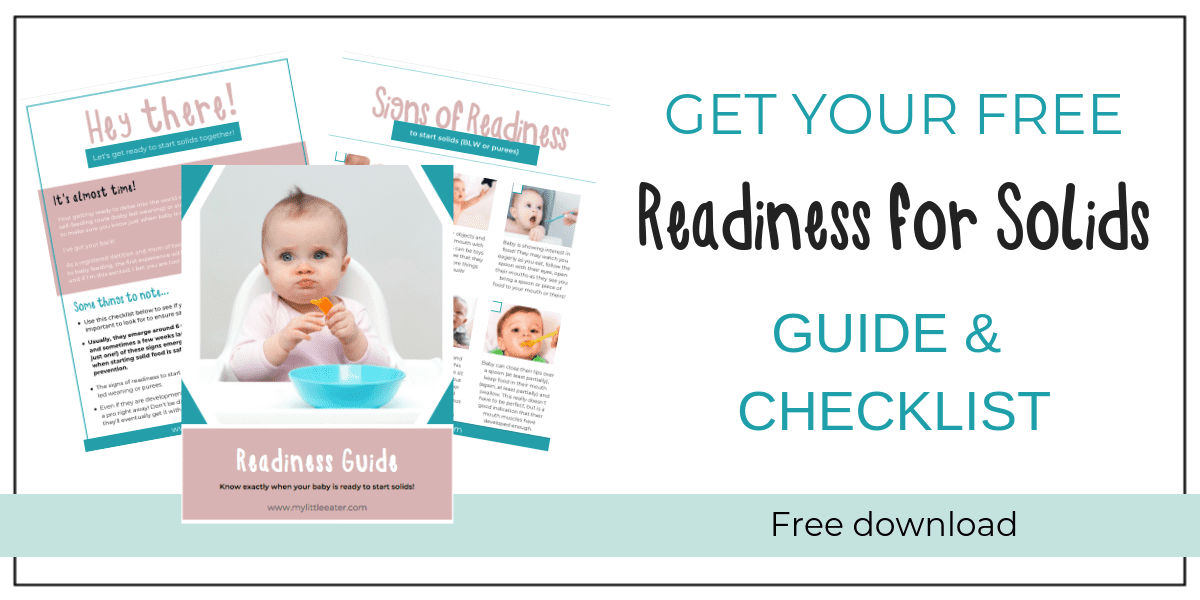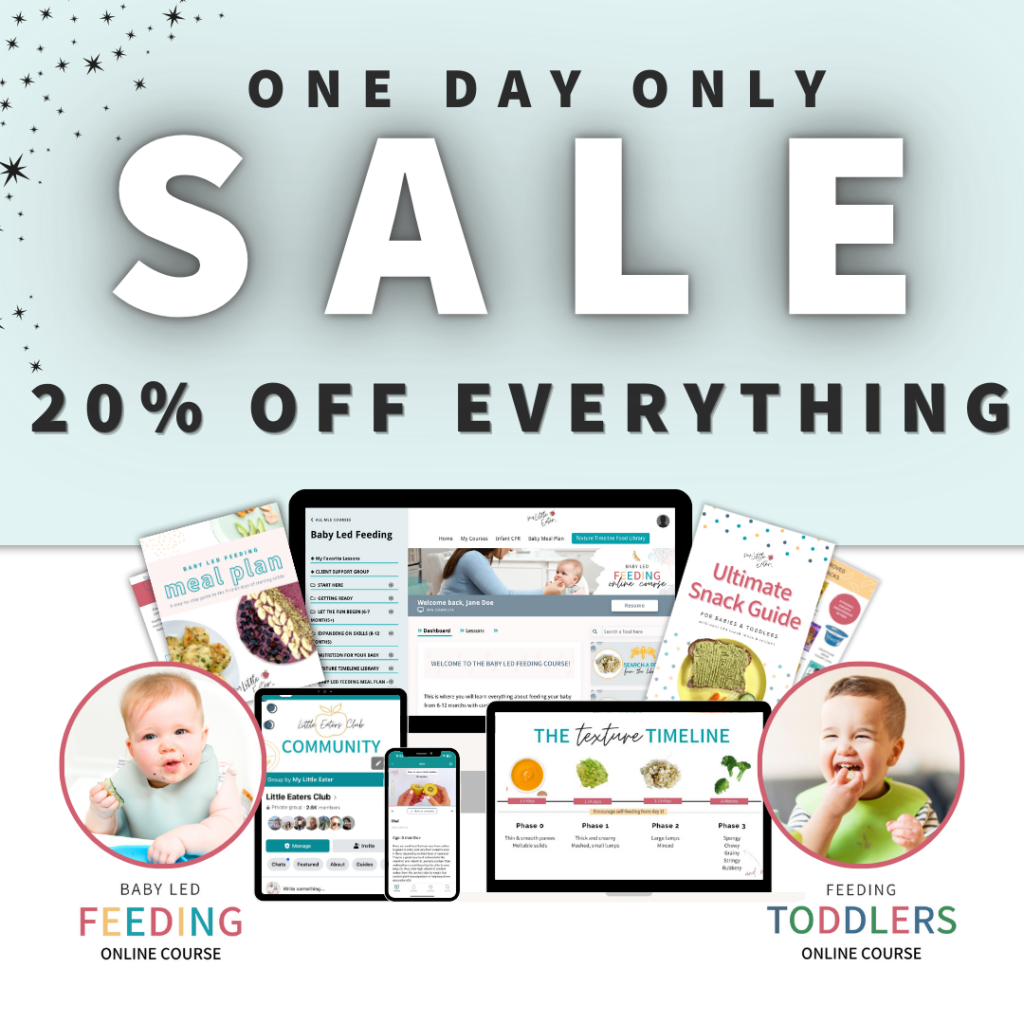![Main image for the article [4 Reasons Why It's OK To Combine Purees & Babyled Weaning!]. Pictured is a baby eating in their highchair.](https://mylittleeater.com/wp-content/uploads/2018/11/New-Blog-Post-Image-Size-8-300x300.png)
Last week I talked about my definition of Baby Led Feeding and how you can use this approach to starting solids with your baby. Missed it? Read about it here.
In a nutshell, it’s letting your baby lead the feeding process, with us parents being super responsive to their cues and stages of readiness (all while challenging them to advance to new textures and self-feed so they become skilled eaters!). Because we are going off our baby’s cues, feeding in a baby led way means that in the beginning, you may want to incorporate purees (spoon feeding) and finger foods into your feeding schedule, based on your baby’s interest level, skills and abilities. It’s a way of mixing approaches as needed if that is what your baby needs. It’s so important to me that we let go of these all-or-nothing rules that we so often find in the mommy world, and learn to be flexible and responsive above all things. This is something I strongly believe every parent should embrace for stress free and successful feeding. In fact, it’s an underlying theme in my online course that teaches parents how to start solids and finger foods from 6 months all the way up to 12 months of age.
Today I’m going to list out four reasons why it’s ok to switch (or combine) approaches (purees and baby led weaning) as needed and what the benefits are of doing so. I’m going to slash through all the myths floating around out there that only one method can be used, or else all is ruined. You can also follow along with our realistic example of the first week of starting solids to see how we recommend combining both methods.
Let’s begin!
The benefits of mixing approaches
1. It stays true to responsive feeding practices
A lot of times, traditional baby led weaning proponents claim that TRUE baby led weaning means your baby can NEVER be spoon fed, and that it’s not actually baby-led if we do the feeding for them. I call BULL. In fact, if we truly want to let our baby lead the feeding process, we will start with whatever method they tell us they are ready for! What I know for sure, is that some babies do well with one method over the other in the beginning stages, depending on their level of independence and what skill level they are at. And some babies take to both methods just fine! For example, you may find some babies show the readiness signs to start solids, but don’t have a mature swallow, are dealing with excessive gagging, or just aren’t interested in finger foods at all. I’ve seen babies take even two months before they show any signs of interest in eating an actual finger food, but will joyfully eat purees! There’s nothing inherently wrong with the spoon – it’s all about how you do it, the simplicity of the textures and how long you are spoon feeding for. So give yourself the freedom to switch from one approach to another as your baby is ready!
2. It allows for nutrient needs to be met
Allowing for flexibility in your feeding approach helps ensure that your baby is getting lots of good nutrition and practice, no matter what. Iron is of particular importance when we talk about the nutrient needs of babies. Your baby’s iron stores begin to deplete around 6 months of age, and while breastmilk and formula contain iron, they do not meet the high requirements your baby needs at the time without food to supplement. If your baby isn’t doing well with finger foods, instead of waiting until 7 or 8 months before they get a hang of it, go ahead and start with high iron purees like puree chicken or lentils in the meantime that will provide them with the nutrition they need. This way, you can take your time, letting your baby continually practice with finger food in the meantime, without worry over whether they’re meeting nutrition requirements or not.
3. It ensures you’re able to introduce allergenic foods in a timely manner
The current recommendations by governing professional bodies are to introduce the common allergenic foods as close to 6 months of age as possible. In fact, delaying the introduction of highly allergenic foods can actually increase the risk of developing an allergy. In order to ensure that this is avoided, you can introduce allergenic foods via purees if your baby hasn’t yet taken to finger foods and get that piece of mind early on. I’ve heard countless times that parents decide to just rely on milk for many months if baby doesn’t seem interested as “Food before one is just for fun” (another blog post to come on why I don’t agree with this). But as you can see already, food before one is very important and introducing allergenic foods in a timely manner is one of them.
4. It reduces stress for the parent (and baby!) and allows for a more flexible lifestyle!
I can’t even begin to tell you how many parents come to me so stressed that their baby isn’t eating finger foods yet in the first few weeks. It’s not always the case, but when it is, it seems that it takes all the fun out of feeding and instead it becomes a huge worry about why they aren’t there yet while so-and-so’s baby is eating like a champ. It becomes all you can think about at every meal. Now assuming that your baby shows all the signs of readiness to start solids, my advice is to go with spoon feeding and not wait or stress yourself out over the fact that they aren’t eating yet! Note: the amount a baby eats at each meal should always be entirely up to the baby and I generally try and encourage parents to let go of the worry over how much they are eating.
Use the mixed approached as needed to keep things working for you and your baby as you listen to their cues. Again, don’t be afraid to flip flop as well. For example, maybe your baby is exceptionally hungry and you offer her finger foods to start. Then, you quickly see she’s frustrated with the speed at which she can eat or ingest finger foods, so you respond by offering her purees in between until she is more content. Then, you re-offer more finger foods and let her finish off the meal on her own.
Or perhaps some parents may feel like family members find it stressful to let baby self-feed when they are in their care. So perhaps as a compromise, purees are given when they are at grandma’s, but finger foods and self feeding is done when the baby is at home with the parents. It’s ok if you don’t stick with one way the entire time. As long as your baby is getting exposure to finger foods as much as you can, and they are eating well, that is all that really matters.
Conclusion
An important note I do want to make before I end this post, is that while puree feeding may help you and your baby in the beginning know that a) they are not mandatory if your baby gets the hang of self-feeding right away 2) It’s important to continually offer finger food at every meal alongside purees for practice and exposure and 3) there is a right and wrong way to feed purees and traditionally speaking, we’ve been letting our babies go waaaayy too long on puree textures alone. If you need help with learning how to properly spoon feed your baby in those beginning stage, you can find a whole lesson on that in my Baby Led Feeding online course as well.
Overall though, you can see how and why I advocate for listening and watching for what’s right for you and your baby over any black and white feeding approach out there. Let loose and tune into your instincts – you know what’s best mama!
 1 day only sale! 20% off with code FLASH20 at checkout
1 day only sale! 20% off with code FLASH20 at checkout 






